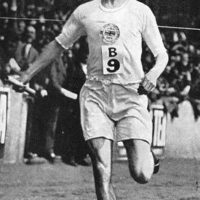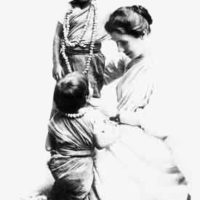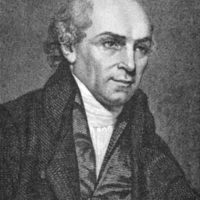“O God! Old and feeble and unworthy as I am,
help me to win them.” – Mary Slessor

Early Life
Mary Slessor was born in Scotland in 1848. Her mother was a Christian. She knew God worked through prayer, so she spent hours praying. Mary’s mother was praying her son, Robert would become a missionary. On the other hand, her father was a shoemaker and drunkard.
Move to Dundee
In 1859, the Slessor family moved to Dundee. Mary’s mother hoped her husband would overcome his addiction to alcohol. Due to his alcoholism, Mary’s father lost his job. Mary started attending half a day of school provided by the Mill and the other half working in the Mill when she was eleven. At the age of 14, Mary started working full time from 6 am to 6 pm. Her only breaks were an hour for breakfast and an hour for lunch.
Conversion
Mary was “a wild lassie” before becoming a Christian. She got into all sorts of trouble and looked back then with both amusement and shame. One day while Slessor was getting into mischief with her friends, an old widow by beckoned them into her house. The widow described the horrors of Hell and the eternal torment facing those who didn’t know Jesus.
Mary couldn’t sleep that night. The idea of eternal torment haunted her throughout the night. She came to the conclusion it would be best for her to make peace with God so she wouldn’t have to go to Hell. Once Slessor learned about the love of Jesus, she never used the same fear tactics to bring anyone into the kingdom.
Learning to Read
Mary did not know how to read until she was 14. Mary taught herself to read since she was working full time and had no way to get an education. She decided like David Livingstone to make time to read. Mary would go to the mill before work and read. Sometimes she would forget the time until the bell for work went off. Many of the mill workers were illiterate. She would get into conversations with Atheists, who were shocked a mill worker knew so much. Often times, Mary would be asked to address groups in Dundee. Mary dreaded these times and refused to stand on the platform above the common people. Instead, she sat with the people and talked to them in a conversational style. The people loved Mary and asked her to come back.
Abuse
Mary and her mother faced abuse from her father especially on Saturday. Often, Mary and her mother would sew anxiously waiting for their father to get back home. Sometimes Mary would get kicked out on the street and forced to stay there for a few nights. Slessor would weep in the cold during her times on the street. These times of abuse would form in her a deeper sense of compassion and empathy for children with no parents. Eventually, her father died of pneumonia.
Ambition to be a Missionary
Mary’s mother took a monthly magazine from the United Presbyterian Church called Missionary Record. Mary was entrenched by the stories in the magazine especially the ones from Calabar.
Mary’s favorite person to read about was David Livingstone. His life inspired her to pursue being a missionary in Africa. When Livingstone died in May 1873, Mary decided she would take the place of David.
One day, a missionary came and spoke at Mary’s church. As he described the work being done in Africa, Mary’s eyes were opened. From that moment, she knew God was calling her to Africa. Her brother was contrary, saying she was only a girl and he would be the missionary in the family.
As it happened, Robert did become a missionary to New Zealand not to Africa. Robert died a few years after starting his service in New Zealand.
Church Work
As a youth, Mary was active in her church. Mary taught Sunday school at her Presbyterian Church. Often times, she would go onto the street and rally youth to attend the Sunday school classes. Many of these youth were part of gangs. Sometimes, the gang members would threaten Mary. She stood her ground though which brought many of them to Christ.
On one occasion a boy threatened to whip Mary if she didn’t leave. She persisted in telling him the Gospel. He was amazed by Mary’s boldness and followed her to Sunday school.
Another boy’s gang circled around her. The leader had a lead pipe. He swung it around as if he was going to hit her with it. Amazingly though, Slessor did not flinch or back off. With the order of the gang leader, they followed her to Sunday school because of her trust in God.
Years later, that boy would have a decent job and a family. He sent a picture of his family to Slessor. His encounter with Jesus had changed his life completely. The gang leader could have easily sat in jail his whole life instead of having a family who he loved.
Slessor was offered another job at the Victoria United Presbyterian Church with the Sunday morning mission service for youth. Mary would go around and knock on tenement doors. Even though they were sleeping, they would follow her. They esteemed Mary and as a result their lives were changed as many of them came to Christ.
Foreign Mission Board
In 1875, Mary applied for the Foreign Mission Board. She offered herself to go anywhere. Mary was accepted and assigned to Calabar as a teacher. Mary’s mother enthusiastically let her go to the training school. In March 1876, Mary started training school. For three months, Mary studied to be a missionary. Finally, in August 1876, Mary sailed off to Calabar.
Calabar
One month after leaving in September 1876, Mary arrived in Calabar. Calabar was known as “the white men’s grave.” Very few outsiders have left Calabar to tell about it. To the tribes of Calabar, life meant very little. They would kill without any remorse and had no sense of right. More horrific than anything was the act of twin killing. People in Calabar believed that having a twin was the result of an evil spirit and a curse to the village.
Mary started in Duke town, where the mission was well established. They had different institutions including schools, hospitals and orphanages. Through all of these, people came to know Christ.
At 27 years of age, Mary started to learn Efik, the local language. Slessor was discouraged by the fact the missionary work was too routine. Mary wanted to explore and go to places where the name of Jesus had never been heard. She also wanted to live in the same huts of the natives instead of the luxurious houses of a missionary.
When Mary picked up the language, she decided to travel alone despite the warning that it might be dangerous. Slessor recognized she could get to know people better without a translator. Many of the places she went to were clustered with missionaries unlike inland Calabar.
Just three years after coming to Calabar, Mary was forced to take a furlough to Scotland due to sickness.
Old Town
When Mary got back to Calabar, she was assigned to Old Town, a town with no missionary in it. In front of the meeting house, there was a skull. In addition, each house had their own gods hanging off the roof. To Slessor, this was a symbol of the darkness in the town.
Mary ministered to the people by providing medical care and teaching the Bible. The chief, King Eyo Honesty the sixth was a Christian and asked her for advice on dealing with outsiders. Mary in turn asked the chief about how to deal with the natives.
Further Inland
Despite the fact Mary’s ministry was successful; she had a burden to reach the Okoyong tribe. These people were in bondage to their drugs, slavery and violence. Slessor couldn’t help but wonder how she could reach out to the Okoyong people?
The people of Old Town and King Eyo Honesty the Sixth tried to dissuade Mary from going to the Okoyong tribe because of their reputation. Slessor was not one to be dissuaded. She insisted on going despite the danger. The chief sent a bodyguard with Slessor to see that she got to the Okoyong safely.
Slessor went completely native. She no longer dressed Scottish but instead dressed as a woman would in Calabar. Mary traveled barefoot and even went to the point of drinking unfiltered water.
What she found would have scared most people off. In the Okoyong tribe, twins were considered the seeds of evil spirits and the second to be born was murdered. On multiple occasions, Slessor intervened before the twins could be murdered. Other times, the twins were dropped onto her doorstep secretly before they could be killed. Slessor adopted many of these children and took them in as her own. At one time, she had as many as twelve children.
In addition, in front of the meeting house, there was a skull. To Mary, this was a symbol of the cruelty and the darkness of the tribe. The women didn’t have any rights and were killed without remorse. Whenever a women’s husband died, she was murdered along with the slave. The Okoyong had the belief they would be able to serve the husband in the afterlife this way.
Many times, people in the Okoyong tribe would fight against each other if they got in a dispute. On one occasion, there was a violent outbreak. Everybody had gotten in a circle to attack each other. Just in time, Mary came between the two groups. One of the instigators threatened to shoot her if she didn’t move. Slessor stood her ground despite the threat. The instigators were amazed at this white woman standing up to them and backed off.
Sometimes Mary had to come up with something clever to intervene in the situation since the conflict was too far for her to get to before any one got killed. On one occasion she was nowhere close to the scene of the violence. Slessor sent a runner with a piece of parchment paper wrapped with a velvet ribbon. Slessor would scribble on it to make it look like an important piece of paper. The instigators spent all day trying to figure out what the piece of parchment paper was until Mary could come and settle the conflict. After breaking up the conflict, Mary would sit and knit at the scene to make sure no other conflict would break out.
Trading
The question was why do the Okoyong continue their violent outbursts? As Slessor looked deeper, she found the tribe had no way of earning an income. This meaningless life led to both drinking and violence. Mary came up with a solution. She asked the chief about trading with outsiders. The chief disapproved of the idea. Despite the chief’s disapproval, Slessor started having the tribe trade. This new trading created inter-tribal peace for the first time. No longer did they fight. In addition, it created good relations with outsiders. King Eyo Honesty the Sixth hosted a feast for the Okoyong. He declared that if they would follow Jesus, then they would always be provided for. The Okoyong were amazed at the hospitality of Duke Town. Many of them started following Jesus because of this. As the Gospel continued to spread among the Okoyong, civilization came to them much faster than it did among the coast. It was only with a change of heart, that the outward change could come.
Judge
In time, Mary was made the judge of the Okoyong tribe by the British government. They were impressed by Slessor’s work and saw she was the most qualified for the job. She settled the disputes of the tribe and stopped their violent ways.
Azo
Mary felt a prompting from God to go to the Azo, a cannibalistic tribe. The Okoyong warned her not to go because she might die. The Azo people were not receptive to the Gospel at first. They had no interest in the God Mary was preaching. In time though, a whole village of 200 people came. The people were illiterate, so Slessor called for pastors to instruct the new believers.
Continued Travels
Mary did not stay in one spot for long. Her goal was to preach the Gospel and then establish a church in the village. Even as Slessor got old, she continued to travel with the help of natives and missionaries.
Throughout her ministry, Mary picked up diseases such as Malaria. Each time, Slessor had to go back to Scotland in order to recover. Mary bounced right back into her ministry after recovering from her illness.
Death
World War I struck in July of 1914.Even Africa was affected by the war. This shocked Mary who after hearing the news, fell ill. She bounced back to her work after recovering in a hospital. After about 40 years of ministry, Mary died on January 13, 1915 while working in Itu.
Legacy
Mary left a legacy not only in Calabar but also in her home town, Dundee. In Nigeria, Slessor is remembered and venerated even to this day. There are festivals throughout Nigeria commemorating her journey to reach the villages with the good news. A hospital was created in her honor in Itu, called Mary Slessor hospital to provide for the medical needs of the community. Churches from Mary Slessor still stand and are vibrant. On a church in Dundee, there is a stained glass window depicting the life of Mary Slessor. The most important thing though is not the buildings and decorations made in her honor. Instead, the changed lives are the most important legacy of all. If Mary had not kept on going further inland with her sickness and opposition, then not as many people would have come to know Jesus.





I would like to know who wrote this article.Could you guys put who wrote it on this article.Thanks
Very Helpful for my research report.
感人的事迹!Amazing!Hallelujah!